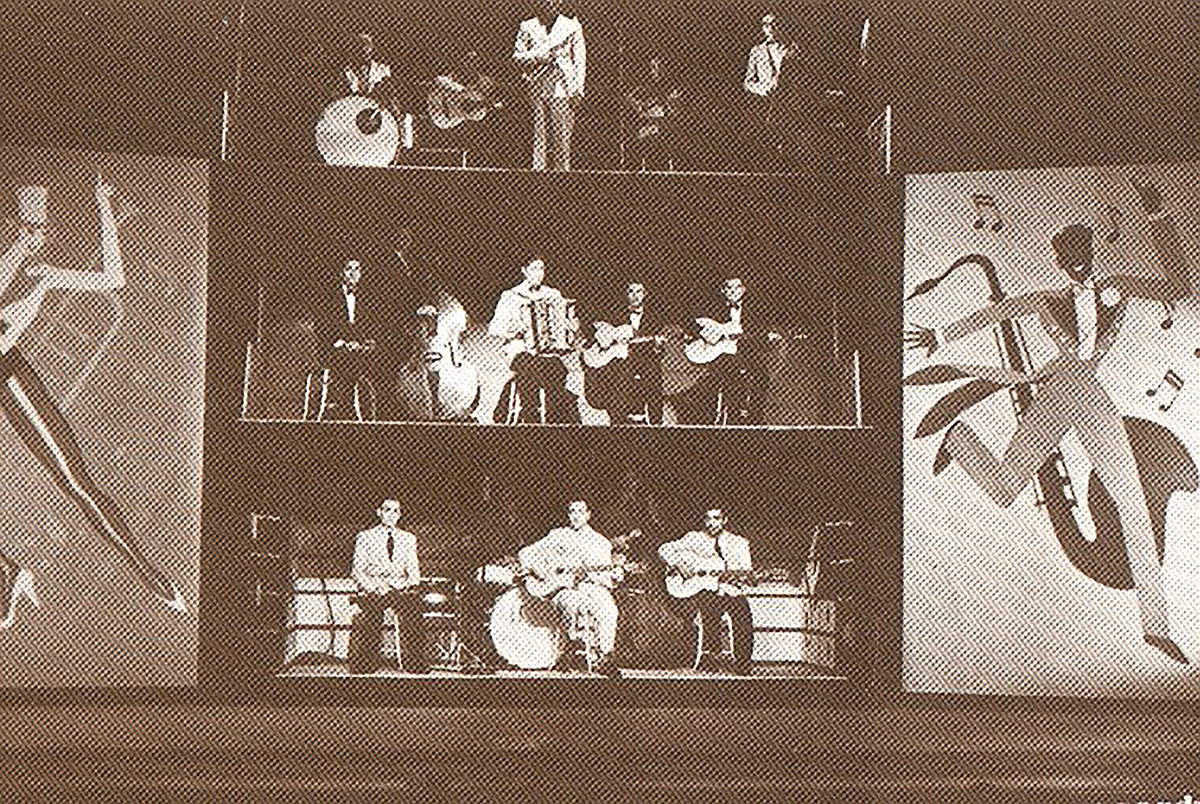
Concert at Moulin Rouge with three bands (top to bottom) Ekyan, Gus Viseur and Django Reinhardt, 1941.
Education of a Genius
It was Ekyan who drew Reinhardt into his first professional job with the ensemble of singer Jean Sablon, 1932-34. Andre was charged with serving as a chaperone and personal minder for Django, helping groom him as a performing musician.
Andre attempted to guide and instruct the novice about showing up for gigs in professional attire with combed hair, clean fingernails, shoes shined . . . and wearing shoes. Just the ‘showing up’ part was a persistent shortcoming for the princely gypsy who was oblivious to clocks, calendars or curtain times. Throughout their association, it was Andre’s responsibility to fetch Django (and a guitar) and get him to the job.
Reinhardt was rustic and astonishingly unfamiliar with “gadjo” (non-gypsy) manners, ways and education. For instance, while awaiting the start of a gig held at a school auditorium he perused a children’s book about dinosaurs. Finding it a comical fable, he rejected the idea that such creatures could ever have existed, saying the other musicians were teasing him.
Django often took newfound enthusiasms — such as fancy clothes, taxis or automobiles — to extremes. There is a tale of him driving to a venue in the mountains in a powerful but spartan sports car dressed only in a tuxedo. He arrived at the gig three days late after being lost in a snowstorm.
The Maestro, The Gypsy and “Big Boy”
Frank “Big Boy” Goudie was a skilled multi-instrumentalist and a friend of both Ekyan and Django. Between the two world wars, the six-foot five-inch Louisiana-born expatriate lived in Paris, performing, jamming or gigging with most of the significant jazz musicians on the continent –French, European or American.
Django and Big Boy shared many late-night jam sessions. When Goudie made the first record under his own name– a 1935 tour-de-force playing on three instruments — he was accompanied by Django on guitar and Stephane Grappelli playing piano.
By the early 1930s Goudie was a well-established performer in Paris. Big Boy’s affiliation with the nascent Federation of Hot Clubs led him to headline a half dozen concerts introducing Django to French jazz enthusiasts and Parisian fans of Swing. And the towering 6’ 5” tall multi-instrumentalist appeared with Reinhardt and Ekyan on the Swing label.
The effervescent piano playing on these tracks is by stride pianist Joe Turner (not to be confused with Kansas City Blues singer, Big Joe Turner). In “Blues of Yesterdays” Goudie doubles on tenor sax and trumpet.
Andre Ekyan (clarinet and alto sax) and his Orchestra, 1939
Frank “Big Boy” Goudie (trumpet, tenor sax), Django Reinhardt (guitar), Joe Turner (piano), Lucien Simoens (bass), Tommy Benford (drums):
Darktown Stutters’ Ball
Blues of Yesterdays
The Sheik
Where’s Django?
Typically, Reinhardt was either late or a no show. Also seen are Georges Marion (drums), Stephane Grappelli (piano), Roger Chaput (guitar) and Jerry Blake (clarinet). Photo courtesy and property of Christine Goudie.
In March 1934 a reviewer for the publication Jazz-Tango-Dancing waxed ecstatic over a concert presenting Django with African American vocalist Alberta Hunter, pianist Garland Wilson, Goudie and Ekyan. “It was the living end when Andre Ekyan, Jungo Reinhardt [sic], his brother and Al Romans joined Big Boy’s band . . . it was delirium incarnate, delirium that lasted long into the night.”
Three decades later in California, Frank told journalist and musician Richard Hadlock in an interview for the San Francisco Examiner (July 1963): “Django had everything. Feeling, soul, technique. He could be sentimental or brutal. He was a natural genius, one of the few who could succeed without training. Sidney Bechet was like that, too.I never saw Django without his guitar. He lived for playing. And he was a wonderful person, not temperamental at all. He made good money, but he always stayed with the gypsies.”
The Impresario and Guitarist on Tour, 1949-50
Django was taking one of his periodic retreats from professional music in 1949 when Ekyan sought him out, convincing him to resume performing. Andre, who had trained as a dentist, discovered that Reinhardt was suffering from bad teeth and arranged for much-needed dental surgery. He was at Django’s side for reassurance, but the procedure almost turned tragic when Reinhardt nearly choked to death on his own blood.
With new teeth, Django returned to performing. Ekyan organized another quintet with the guitarist and began booking gigs, performing in or near Paris at Pavillion de l’Elysee, Paris, Paris, the Casanova and Le Touquet. Then they set off on tour playing the South of France, Cote d’Azur, Switzerland and Rome — with Andre again serving as Reinhardt’s personal chauffeur and valet.
Reception was tepid for the quintet in Italy. But they had a jam session with the Roma Jazz Club and Benny Goodman dropped by to hear Django. They made recordings at the RAI broadcast studio, demonstrating that the two artists had moved beyond the Age of Swing to modern combo jazz.
Reinhardt probably adopted the amplified guitar late in his career for many of the same reasons as other guitar players — for dynamic power, parity with the horns and highlighting fine details. But his electric guitar tracks lack the delicate overtones that were the signature of his acoustic sound.
Django’s introverted compositions — like his biggest hit, the rhapsodic “Nuages” (Clouds) — remind us that a substantial element of his appeal was evocative mood music. These are all original tunes conceived by the intuitive genius.
Quintet, Rome 1950:
Django (electric guitar), André Ekyan(clarinet, alto sax):
Black Night
Django’s Castle
Micro
Nuages
Place de Brouckere
A Last Jam in Rome
Before departing Italy, there was a fabulous all-night jam session at a villa outside Rome. Participants included trumpeter Roy Eldridge, saxophonist Zoot Sims, harmonica player Toots Thielemans and drummer Ed Shaughnessy.
Writer Michael Dregni described the occasion in Django Reinhardt and the Illustrated History of Gypsy Jazz: “Django was taken by composer Anton Karv’s zither soundtrack to the recent movie The Third Man, and Django played the theme song, using its eerie mood as jumping off point to explorations. As [bass player Alf] Masselier said, ‘In my life as a musician — and I accompanied everyone, from Coleman Hawkins to Don Byas — I never heard an improviser like Django’.”
The end of that tour in June 1950 seems to be the last evident association of the two before Django’s death in May 1953. Andre’s professional music career lasted into the 1960s. Ekyan made cameo appearances in French cinema and was in one of the earliest Jazz documentaries on film — with Reinhardt as the subject.
The reverberations of Django’s music are stronger than ever. Today, there is a thriving international Gypsy Jazz and Hot Club Swing movement, thanks in no small part to a partnership between an energetic Maestro and the gifted Gypsy guitarist.
Thanks to Hal Smith for assistance and Richard Hadlock for his 1963 San Francisco Examiner article.
Sources and further reading:
Towering Reedist Goudie: Clarinetist ‘Home’ After Years Abroad with Top Bands, Richard Hadlock, San Francisco Examiner, July 28, 1963
BIG BOY: The Life and Music of Frank Goudie, Dan Vernhettes, Christine Goudie, Tony Baldwin (JazzEdit, 2014)
Django Reinhardt and the Illustrated History of Gypsy Jazz, MichaelDregni (Speck Press, 2006)
Jazz Away from Home, Chris Godard (Paddington Press, 1979)
La Tristessede Saint Louis: Jazz Under the Nazis (Beech Tree Books/William Morrow, 1985)
Making Jazz French: Music and Modern Life in Interwar Paris, Jeffery H. Jackson (Duke University Press 2003)
- ← Previous page
- (Page 2 of 2)

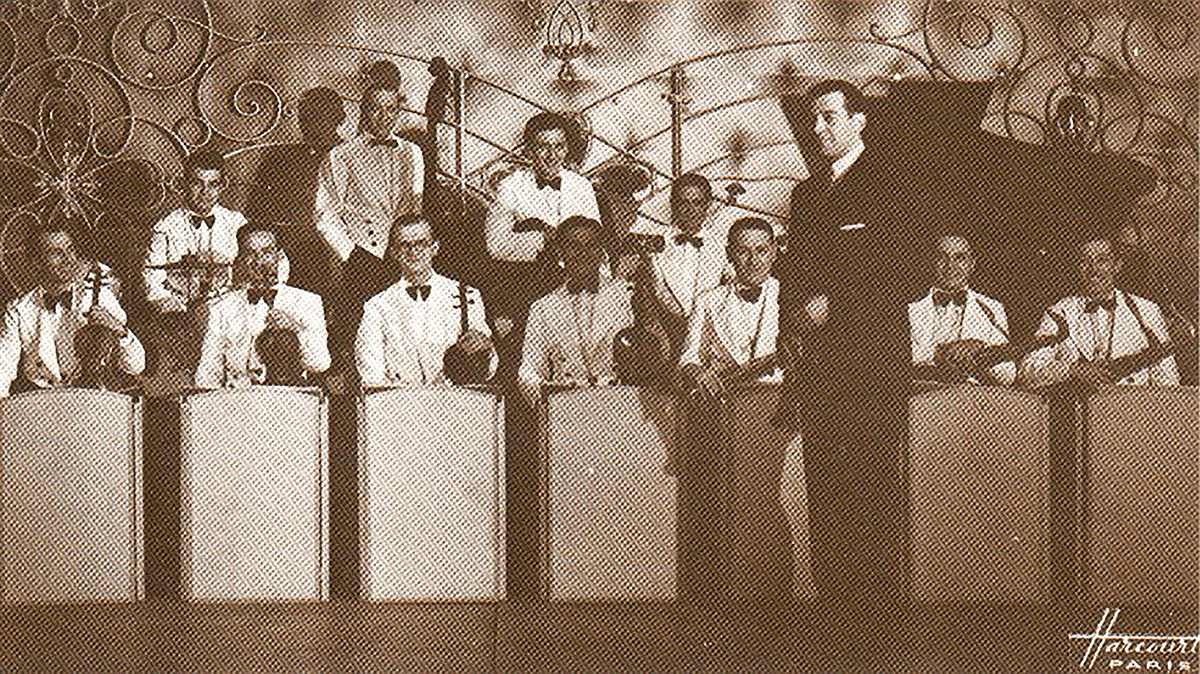
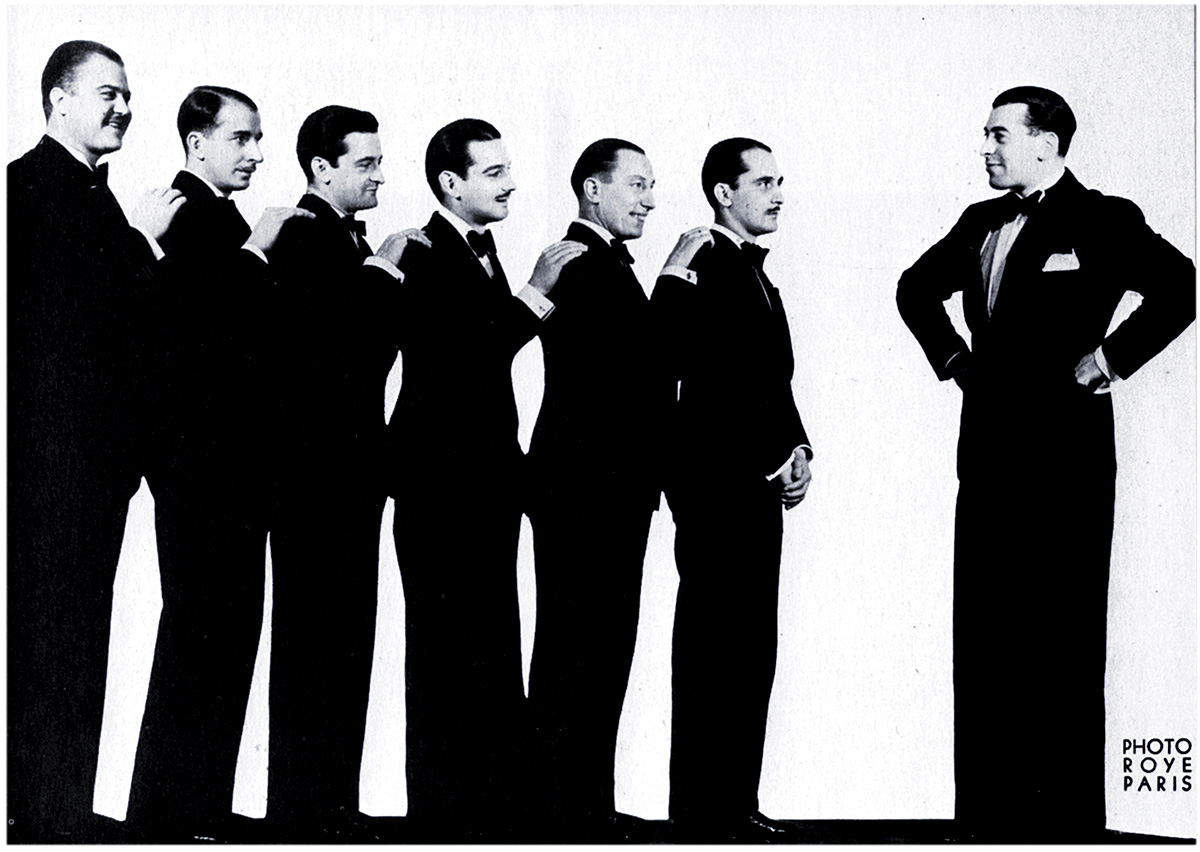
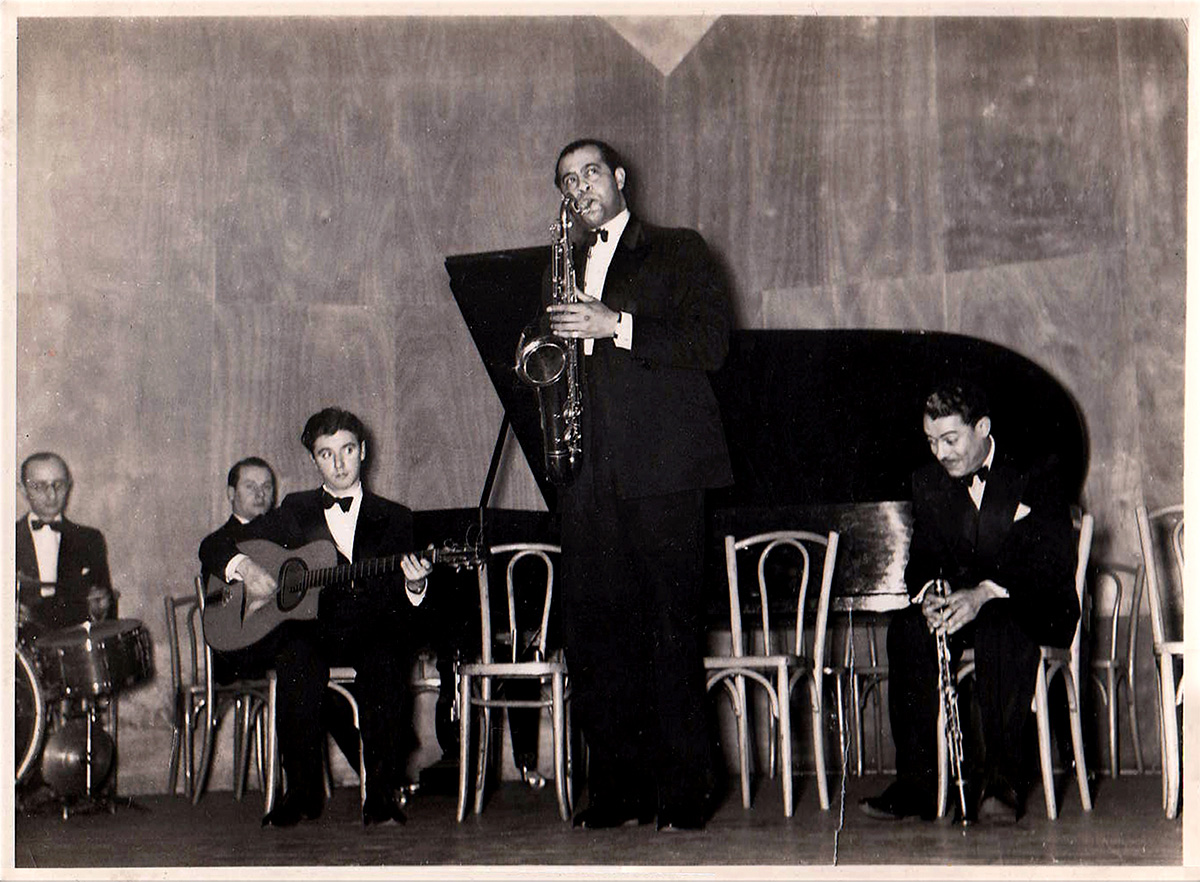
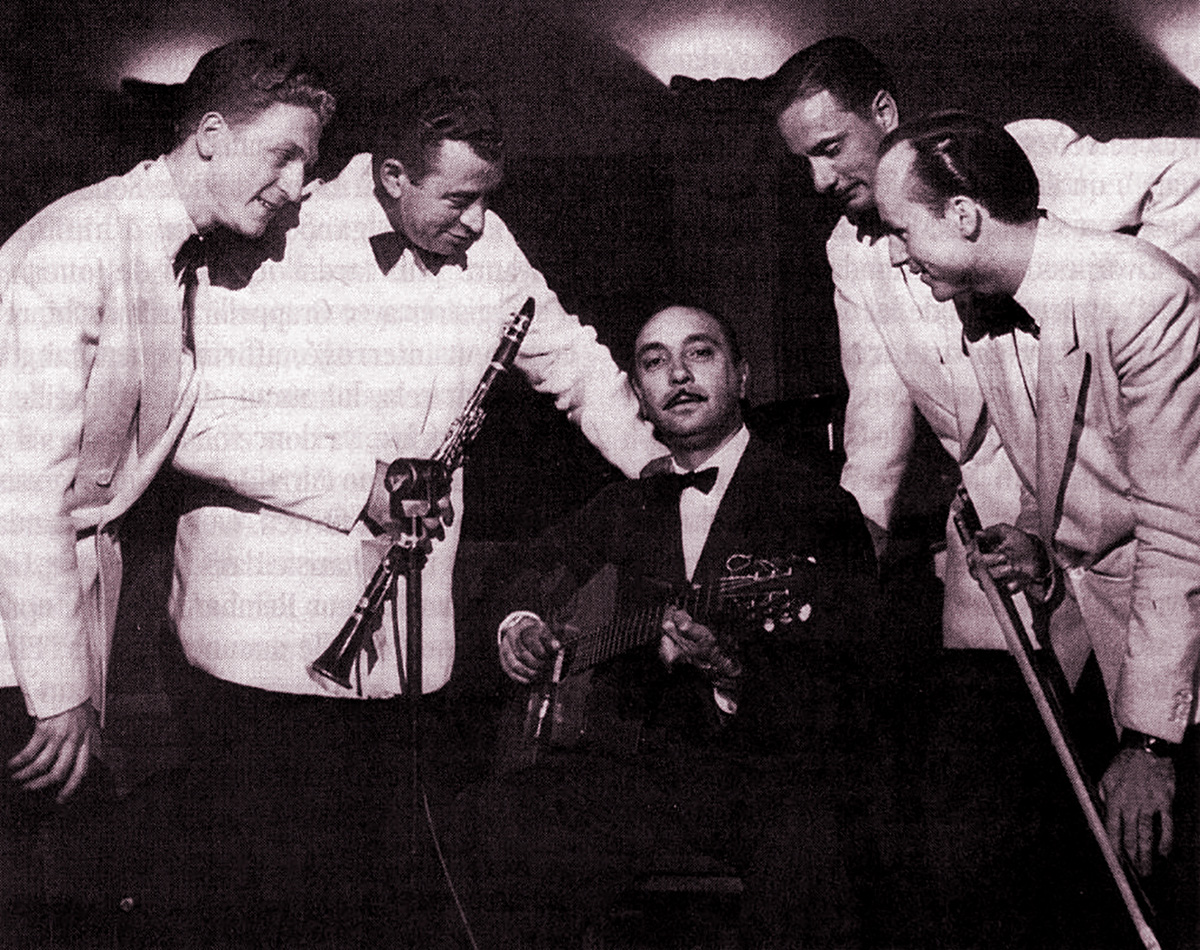
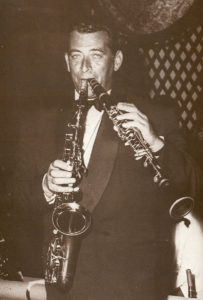
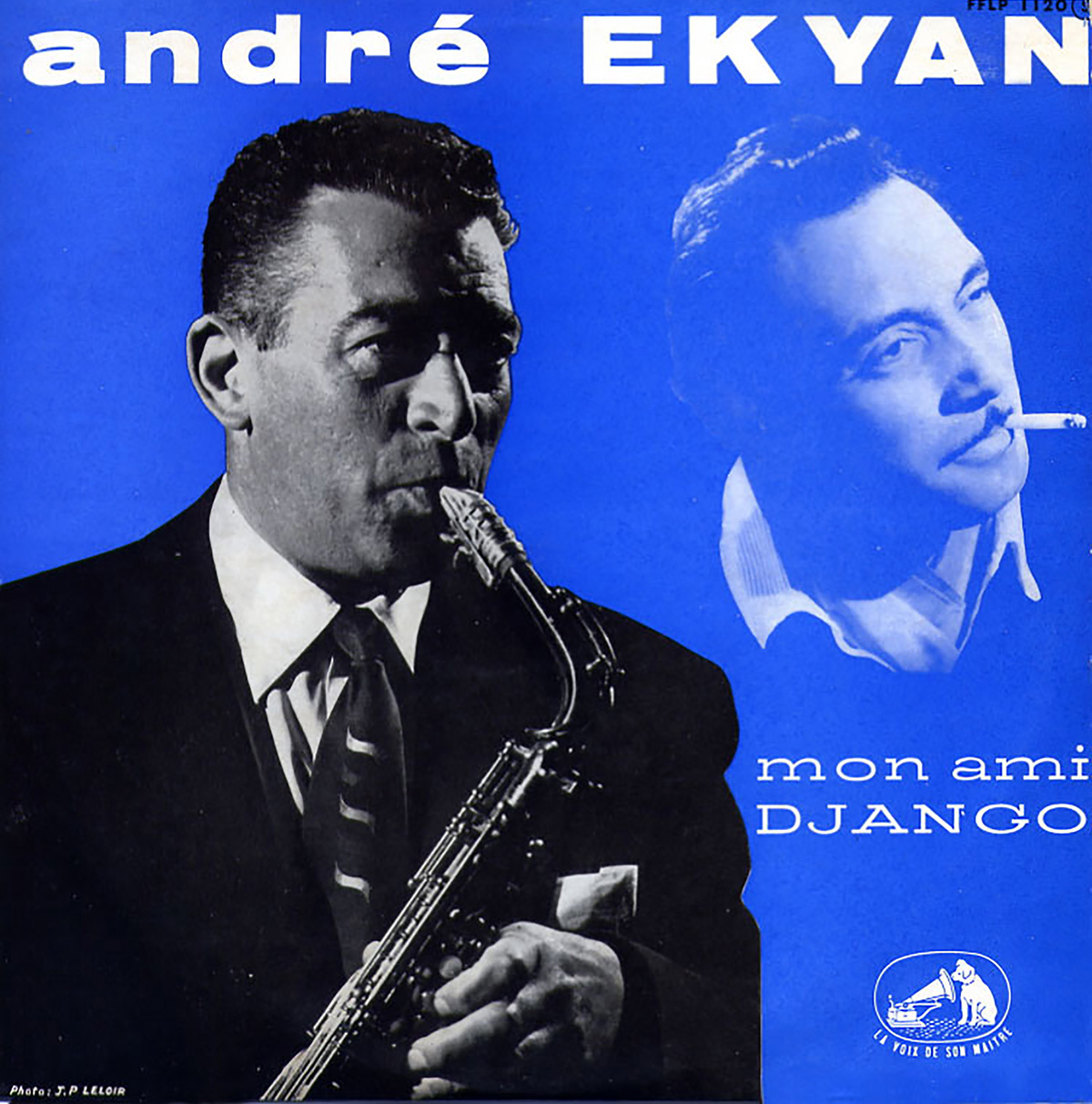
Further explorations:
Andre Ekyan on JAZZ RHYTHM
http://www.jazzhotbigstep.com/293212.html
Ekyan – Keep Swinging Blogspot
http://keepswinging.blogspot.com/2009/03/andre-ekyan-saxophone-player-1930s.html
Django on JAZZ RHYTHM
http://www.jazzhotbigstep.com/242.html
Frank Goudie in Paris, 1924-39
http://www.jazzhotbigstep.com/752934.html
Frank Goudie’s Paris Associates
http://www.jazzhotbigstep.com/137101.html
Towering Reedist Goudie: Clarinetist ‘Home’ After Years Abroad with Top Bands, Richard Hadlock, San Francisco Examiner, July 28, 1963
http://jazzhotbigstep.com/GOUDIE_Hadlock_Examiner%207.28.63_D.pdf